|
< Earlier Kibitzing · PAGE 5 OF 5 ·
Later Kibitzing> |
| May-16-15 | | SirRuthless: Very nice game by Caruana. He played for positional domination with the early g4. He is showing his class. A win over Tomashevsky is worth two wins in terms of winning this event outright and it would take some hard work for him not to qualify at this point. |
|
| May-17-15 | | whiteshark: GM <Jan Gustafsson> takes a look at the game between the two overall leaders of the Grand Prix: http://www.youtube.com/watch?v=v0e3... Enjoy a great annotator! |
|
| Jun-01-15 | | Jambow: <offramp: An asymptonomiarch is a man holding a name similar to another but in no way ever exactly being the same as it.> Thanks had me wondering.
<perfidious> Still hurt I see ;0] |
|
Jun-03-16
 | | Penguincw: Looks like a recent game.
And well, it was, as I see it was a live broadcast last year. Anyway, looks like an easy Friday puzzle (wow), with 31.e6 Rf6 32.e7+ Rf7 33.e8=Q+, white is winning. (sees 31...Re7)
Of course it can't be that easy. But if faced with this OTB, I'd probably attack the rook, but with 32.Rd7, but the rook doesn't have to move or anything, since it's guarded by the bishop. |
|
| Jun-03-16 | | dfcx: The first move is easy to spot,
31.e6 attacks the rook and opens up the diagonal for the queen. A. 31...Re7 32.Bh4 wins the exchange. If black tries to save the rook with 32...Re8? 33.e7+ Qf7 34.Re6 wins B. 31...Any other moves 32.e7+ followed by Rd8+ promotes. C. 31...Bxe1 32.exf7+ wins a piece. |
|
| Jun-03-16 | | Cheapo by the Dozen: I did part of this one, very quickly.
A. e6 is the obvious threat.
B. The only reasonable-looking chance for defense is to blockade the pawn with ... Re7. C. Bh4 does bad things to the blockade.
I didn't follow through to check what happens after Black reestablishes the blockade at e8. |
|
| Jun-03-16 | | agb2002: The material is identical.
Black threatens 31... Bxe1.
The natural maneuver seems to be 31.e6 Re7 (31... Bxe1 32.exf7+ Qxf7 33.Rxe1 + - [B vs P]) 32.Bh4: A) 32... Bxe1 33.Bxe7
A.1) 33... Re8 34.Ba3
A.1.a) 34... Bb4 35.Rd8 Kf8 36.Bxb4+ axb4 37.Qxb4+ c5 38.Qxb6 wins two pawns at least (38... Qxe6 39.Qxe6 wins). A.1.b) 34... b5 35.Rd8 Rxd8 36.e7+ wins.
A.2) 33... Bxf2 34.Bd8 Kf8 35.e7+ Ke8 36.Qg8+ Qf8 37.Qxf8#. B) 32... g5 33.Bxg5 looks similar to A, with an extra pawn (33... Qxg5 34.Rg1). C) 32... Ree8 33.Rd7 Bxe1 34.Rg7+ Kh8 (34... Kf8 35.e7+ Rxe7 36.Q(R)g8#) 35.Rf7 and the threat Bf6 looks winning. For example, 35... Qd5 36.Qxd5 cxd5 37.Rxh7 Rxe6 38.Rh8+ Kf7 39.Rxa8 and Black can't stop the h-pawn. |
|
| Jun-03-16 | | The Kings Domain: Pretty tough puzzle, and a good attacking game by Caruana. |
|
| Jun-03-16 | | diagonalley: the pawn push is instinctive, though it's not easy to anticipate how black will choose to defend... quite a bit of play is needed to convert the advantage |
|
| Jun-03-16 | | patzer2: A few days ago I played over Caruana vs Radjabov, 2016 where Caruana won with the White pieces with a similar crushing 34. e6! So in this Caruana game I couldn't resist going for 31. e6! as my solution to today's Friday puzzle. However, after 31...Re7 I picked 32. Rd7 which also wins as the computers indicates play might continue 32...Rae8 [(a) 32... Rxd7 33. exd7+ Kf8 (33... Kh8 34. Re8+  ) 34. Re3 ) 34. Re3  (b) 32... Qf6 33. Re4 Rae8 34. Bh4 g5 35. Rg4 Qxe6 36. Rxg5+ Kh8 37. Rxe7 Qxb3+ 38. Kxb3 Rxe7 39. Bg3 Bd2 40. Be5+ Rxe5 41. Rxe5 Bxh6 42. Re6  (c) 32... Qh3 33. Re4 Rae8 34. Qc4 Qxh6 35. Bh4 Qh5 36. Bxe7 Bxe7 37. Qxc6 Qc5 38. Rc4 Qxc6 39. Rxc6 h5 40. Rxb6 Bc5 41. Rc6 Bf8 42. Kb3 Bg7 43. Rdc7 Kf8 44. Rf7+ Kg8 45. Rcc7 Be5 46. Rce7 Rb8+ 47. Rb7 Rxb7+ 48. Rxb7 Kf8 49. Rf7+ Ke8 50. Ra7 Bf6 51. Kc4 Bd8 52. Rg7 Bb6 53. Rxg6  ] ] 33. Re3 Qf6 (33... Qf8 34. Bh4) 34. Bc7 g5 35. Bxb6 Qxh6 36. Bd8 Rg7 37.
e7+ Kh8 38. Bb6  (+8.91 @ 22 depth, Deep Fritz 15). (+8.91 @ 22 depth, Deep Fritz 15). In playing guess-the-move with the game continuation, I missed White's strong 34. Re6!  (+10.10 @ 24 depth, Deep Fritz 15). However, my simple try 34. Re3 (+10.10 @ 24 depth, Deep Fritz 15). However, my simple try 34. Re3  (+4.26 @ 24 depth, Deep Fritz 15) also wins. (+4.26 @ 24 depth, Deep Fritz 15) also wins. For a Black improvement, the computer suggestion 19...b5 = (0.00 @ 37 depth, Stockfish 180515) appears to give Black better counter play than the game continuation. Early in the opening, I slightly prefer the popular move 4...e6
as in Aronian vs Anand, 2013. |
|
| Jun-03-16 | | patzer2: Though the game move 35. Rd8  (+6.47 @ 26 depth, Houdini 4 x 64) wins easily, the computer choice 35. Rd7 (+6.47 @ 26 depth, Houdini 4 x 64) wins easily, the computer choice 35. Rd7  (+11.47 @ 21 depth, Deep Fritz 15) is a neat alternative. (+11.47 @ 21 depth, Deep Fritz 15) is a neat alternative.After 35. Rd7! (diagram below)
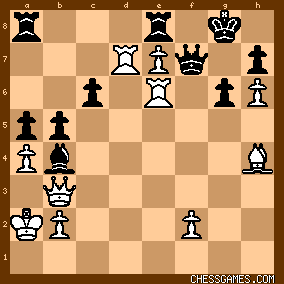
click for larger viewplay might continue 35...Kh8 (35...Rab8 36. Rxg6+ hxg6 37. h7+ Kg7 38. h8=Q+ Rxh8 39. e8=Q Qxd7 40. Qxd7+ Be7 41. Qxe7+ Kh6 42. Qbe3+ g5 43. Q3xg5#) 36. Rd8 Bxe7 37. Rxa8 Rxa8 38. Rxe7 Qd5 39.
Bf6+ Kg8 40. Qxd5+ cxd5 41. Rg7+ Kf8 42. Rxh7  (#8, Deep Fritz 15). (#8, Deep Fritz 15). |
|
| Jun-03-16 | | morfishine: Perhaps too well known |
|
Jun-03-16
 | | Richard Taylor: I saw the ideas here (although I played some of the game after I thought 1. e6 was the best move). But on move 35. Rd7 (and I also looked at Rg1 as I saw someone mentioned "setting up Rxg6+"!) but I thought 35. Rd7! was the ticket and my chess computer agrees heartily showing that Caruana chose a weaker line (35. Rd8?!) than I would have, which proves that I am a Super Grand Master!! |
|
Jun-03-16
 | | Richard Taylor: Actually I think I saw this game about the time it was played as I recall that combination using the pin on f7 and winning the Q or there is even a mate on h8. Interesting game. But Rd8 won so it won: chess is a game of error as well as great ideas and continuations but chess players miss things at all levels for reasons related to the tension of the game, time trouble added, luck (as in some of Alekhine's combinations for example) etc etc |
|
| Jun-03-16 | | PJs Studio: 34.Re6! Nice!! I couldn't calculate well enough at first to see 34.Rd8?? Loses immediately to 34...Bxe1 (Blacks rooks defend one another.) I don't know if I ever would see a move like 34.Re6... Just not a move in my repetiore. Of course, I'll never be a super GM either. |
|
| Jun-03-16 | | kevin86: After the e-file pressure, the final blow comes in a threat at g7! |
|
Jun-03-16
 | | Jimfromprovidence: 36 Qc4 also looks good. It keeps the pin on.
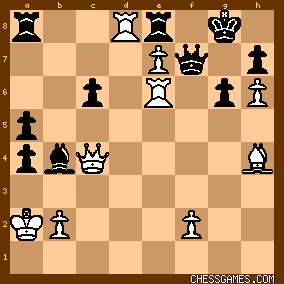
click for larger viewOne continuation is 36...Bxe7 37 Rxa8 Rxa8 38 Bxe7 Re8 39 Qxc6. 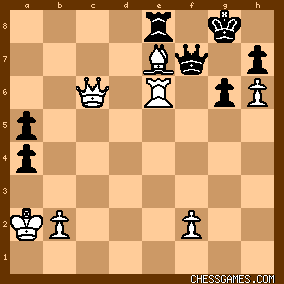
click for larger view |
|
| Jun-03-16 | | morfishine: <Jim> 39...Rxe7 now it's White who's pinned |
|
Jun-03-16
 | | Jimfromprovidence: <Morf> if 39...Rxe7, white can liquidate to a favorable king and pawn ending beginning with 40 Qa8+.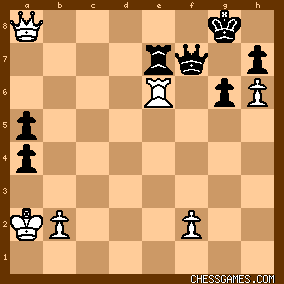
click for larger viewIt goes 40...Qf8 41 Qxf8+ Kxf8 42 Rxe7 Kxe7 43 Ka3.
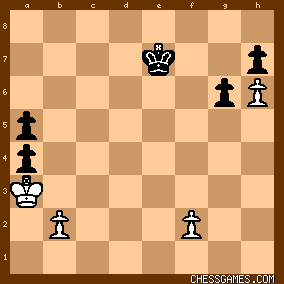
click for larger view |
|
| Jun-03-16 | | YouRang: Got the main idea.
The e-pawn is begging to be pushed:
<31.e6 Re7 32.Bh4 Ree7> is pretty straight-forward.
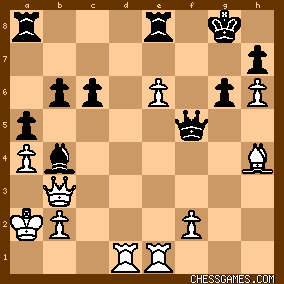
click for larger view
Now it starts getting a little murkier. I wasn't quite confident that I could keep the pawn safe after e7+ here, so I opted for <33.Rd7>, because a rook on the 7th rank in this position looks particularly deadly thanks to our pawn control of f7 and g7, even if it means I lose the rook on e1. If <33...Bxe1>, then <34.Rg7+ Kh8 (...Kf8? Rxg6#) 35.Rf7!>
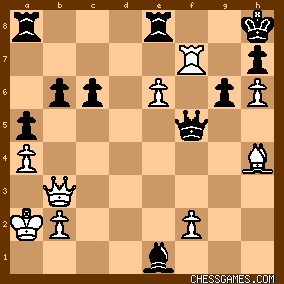
click for larger view
While attacking the Q, white threatens 35.Bf6+ (which looks mating since we can forcible clear our Q's path to g8# following Rf7+ and e7+). If 35...Qxe6, then we remove its defender with 36.Rf8+! Rxf8 37.Qxe6  |
|
| Jun-03-16 | | morfishine: <jimfromprovidence> Of course, this game was a very nice example of positional play leavened with tactics...something that chess players should take to heart: Solid positional play lead to great tactics, not vice-versa After all, even a monkey can learn tactics; but if one neglects positional play, one never has a chance to showcase those tactics ***** |
|
| Jun-03-16 | | King.Arthur.Brazil: I find the whole idea, but played 36.Qc4 instead of 36.Qe3, but the former is best, due to the ending. I didn't find 34.Re6, I moved Rd8 which is wrong cause the Re1 is under BB attack, my fault, I forget it. I dind't play 41.Qc3 but Qd4, but I didn't see any difference. For closing the analysis, I thought about why did Black resign? Well, after 41... Qf7 (lonely), 42.Rf6!Qxe7 43.Re6 Qxe6 44.Qg7# or 43...Qf7 44.Rxe8+ Qxe8 (forced) 45.Qg7#. Maybe, everybody saw it. Very good! |
|
| Jun-03-16 | | BOSTER: <Pjs Stidio:34.Re6! Nice!!>.
Because two white pieces Qb3 and Re1 under attack he has only one move to prevent
exchange the queens Re6.
So, explamation point is not necessary. |
|
| Jun-03-16 | | devere: It seems that after 31.e6 Re7 32.Bh4 Ree8 33.e7+ Qf7 34.Re6 b5 35.Rg1! would get Black's immediate resignation. There really is no defense to the threat R(e)xg6+
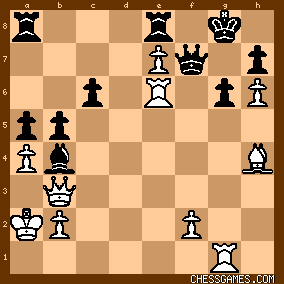
click for larger view |
|
| Jun-04-16 | | stst: Quite the time again...
Difficult as the defending lines are too many..
One main line is to forge ahead the pawn e6, another - simply sac the Q for the R@f7.
IF
(I) 31.e6 Re7 is quite natural
32.Rd7
(A)32...........Rxd7
33.e7 dis+ Kh8
34.Be5+ Qxe5
35.Rxe5 Bxe7
36.Qf7 Bf8
37.Qxd7 .... etc should prevail
(B)32...........Bxe1
33.Rxe7 Bxf2 (i)
34.Rg7+ Kh8
35.e7 Qe4
36.Qf7 Bd4
37.Rxh7#
If (i) ..... Kh8
34.Rf7 Qd5
35.QxQ dxQ
36.e7 Bb4 .... still some way to go
2nd main line
(II) 31.Qxf7+ QxQ
32.e6.... then depends on whether Black yield back the Q (by Qxe6, hence RxQ) or Q blocks, by Qe7 .... some involved variations ensued..... see how it unravelled. |
|
 |
 |
|
< Earlier Kibitzing · PAGE 5 OF 5 ·
Later Kibitzing> |





